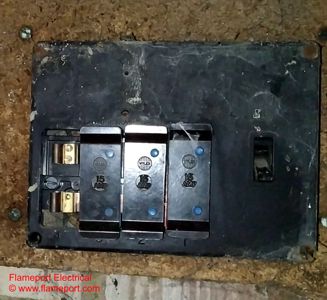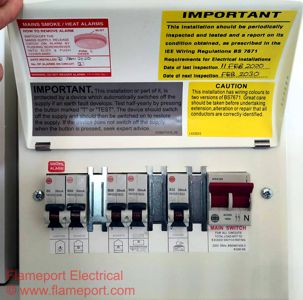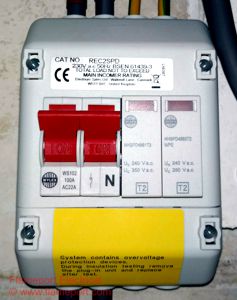Flameport Electrical - Consumer Units
A new consumer unit will offer much greater levels of protection compared to an older model or an outdated fusebox.
Flameport Electrical can install a new consumer unit, including a full test and inspection of the entire installation, ensuring that it is safe and suitable for continued use.
Replacement
Replacing a consumer unit is not just remove the old and install the new. An existing installation must be fully tested and inspected to ensure it is safe for continued use, and it's very likely that some minor repairs will be required.
Typically, it will involve:
- Full test and inspection of all existing circuits
- Repairs where required
- Reconfiguration of existing circuits where required
- Upgrade or installation of main equipotential bonding to water, gas and other metallic services
- Removal of the old consumer unit or fusebox
- Installation of the new consumer unit, including new supply tails and earth connection
- Tests on all circuits connected to the new consumer unit
- Completion of the required certificate and other paperwork.
In almost all installations, this is at least a full days work, and can easily be more for larger installations or those that require more extensive repair.
Beware companies and individuals that offer such things done in just a few hours - they may be cheap, but you are only getting a small part of what needs to be done.
The old one works - why replace?
 Something working and it being safe are two very different things. Domestic installations should be inspected and tested every ten years - more frequently in some situations.
Something working and it being safe are two very different things. Domestic installations should be inspected and tested every ten years - more frequently in some situations.
Unfortunately there are many installations which haven't been inspected in decades, and that assumes it was all done properly in the first place.
Subsequent alterations and additions may have been done correctly - or perhaps not.
RCDs
An RCD is a device which continuously monitors the current flow in the line and neutral conductors, and disconnects the supply if any difference is detected. This could be due to a cable being damaged, a faulty appliance or someone touching a live part.
RCDs are designed to protect people and save lives - disconnecting the power if more than 30mA (0.03 amps) flows somewhere other than the circuit wiring.
Fuses and circuit breakers are there to prevent the cables from overheating. They will not disconnect if someone touches a live wire.
Many older consumer units have a single RCD that covers some circuits only. Some do not have RCDs at all, including older installations with cartridge fuses or rewireable fuses.
A few have a single RCD that covers all of the circuits - but this means that any fault results in the entire house being disconnected, and remaining that way until the fault is removed.
Dual RCD consumer unit or RCBOs?
 A popular solution in the past, and still installed by some today, a dual RCD consumer unit has two RCDs, with the installation split into two parts. A fault that causes one RCD to trip will disconnect about half of the circuits, leaving the rest operational.
A popular solution in the past, and still installed by some today, a dual RCD consumer unit has two RCDs, with the installation split into two parts. A fault that causes one RCD to trip will disconnect about half of the circuits, leaving the rest operational.
While this is better than having everything disconnected, it is still very inconvenient. A faulty toaster could result in the lighting upstairs being disconnected, or a defective electric shower might result in the supply to your home office being cut off.
A further problem is that many modern devices have a small amount of earth leakage in normal operation, and even a moderate number of such things connected to a single RCD can cause tripping even when there is no fault. Multiple circuits all connected to a single RCD is a solution from decades ago, and not appropriate for any modern installation.
RCBO
An RCBO is a single device that contains both an MCB (circuit breaker) and an RCD. With these, any fault only disconnects one circuit - others are unaffected.
RCBO consumer units do cost more than the dual RCD types, but for smaller installations the difference is insignificant.
Larger installations typically with 10 or more circuits will be cost significantly more - but in reality a dual RCD consumer unit isn't appropriate for those anyway and never was.
Surge Protection
 Surge protection is required for most installations, and is normally included in the consumer unit or isolator switch to protect equipment in the installation from high voltage transients or spikes.
Surge protection is required for most installations, and is normally included in the consumer unit or isolator switch to protect equipment in the installation from high voltage transients or spikes.
Voltage transients can damage electronic equipment, which in a modern home is almost everything - even traditionally basic appliances such as cookers, washing machines and fridges now contain electronic devices.
Properties with overhead supply cables and/or those in areas with high levels of lightning strikes each year are particularly vulnerable. However properties with underground supplies are certainly not immune, as many high voltage transients are caused by other electrical equipment being switched on or off, both within the installation and in nearby ones.
Arc Fault Protection
Arc Fault Detection Devices, or AFDDs are a relatively new protection device. They continuously monitor and analyse the current flowing in a circuit and will disconnect power if arcing is detected.
For a free, no-obligation quote to replace your old fusebox or consumer unit, please contact me.


